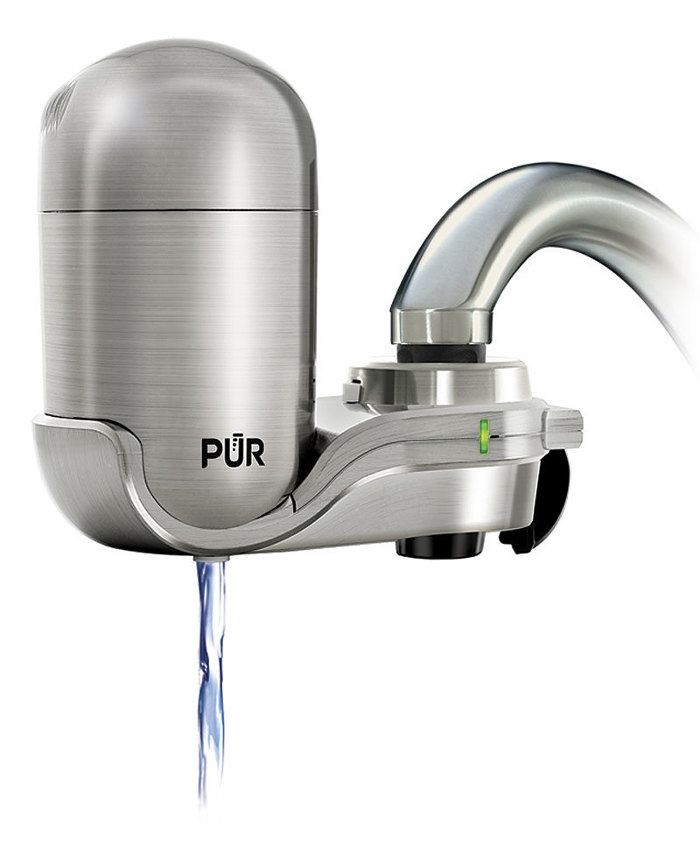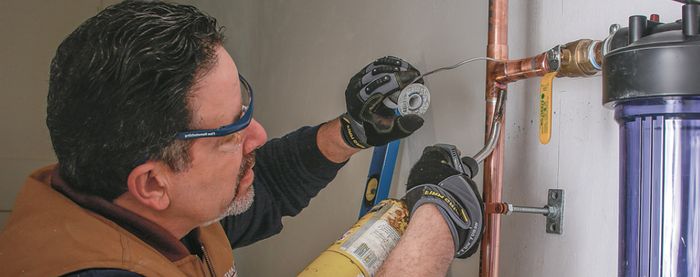Drinking-Water Filtration Systems
Learn about 4 different ways to filter out contaminants from drinking water.

Two atoms of hydrogen and one atom of oxygen—this simple formula makes possible the presence of life on our planet. Not only do we humans owe our existence to H2O, but we must consume it every day for optimal health. The water that comes into our homes from wells and municipal distribution systems contains more than just hydrogen and oxygen, however.
The EPA regulates 86 different water contaminants, and its most recent Contaminant Candidate List (from 2009) includes 116 additional contaminants known to exist in drinking water in the United States that the agency is considering regulating in the future.
To determine if you need to filter your water, start by obtaining your utility’s consumer confidence report (CCR). Water utilities are required by law to provide this annual report, which documents the contaminants present in that utility’s water system. This will give you an idea of which contaminants you need to focus on. Because a CCR applies to the system as a whole and not to your home’s water supply, a more accurate picture of the contaminants you are ingesting can come only through a test of your household water. (For households whose water is supplied by a well, of course, a test is the only way to find out about contaminants.) To find an approved laboratory, go to epa.gov/safewater/labs.
Carafe Systems
The easiest way of accessing filtered water is by using a carafe with a built-in carbon filter, which traps contaminants in the porous surface of its tiny granules of carbon. Many people choose these systems primarily for the way they improve the taste of tap water, mostly through reducing chlorine, which is added to public water supplies as a disinfectant. Depending on the particular system, they can reduce the presence of a number of contaminants as well. With this type of system, as with all water-filtration systems, read the manufacturer’s list of contaminants the system has been tested to filter out to make sure that it includes those present in your water.
Large families may find carafe systems inadequate. The amount of water that a carafe holds may not be enough, and the short life of the filters, which last for about 40 gal. each, may require frequent changing.
Shown: Brita Capri, $35 (available at bedbathandbeyond.com); replacement filters, $25 (set of four)

Faucet-Mounted Systems
The base in these systems attaches directly to the faucet after the aerator has been removed, then a replaceable carbon-filter cartridge is inserted into the base. Though much more convenient than the carafe systems, even the slimmest faucet-mounted system can look like an ugly appendage, especially if it doesn’t match the finish of the faucet. (Some manufacturers offer systems in a variety of finishes.) Depending on the model, filters in faucet-mounted systems last for between 100 gal. and 200 gal. These systems are meant to be used with cold water only; hot water can damage the filter.
Faucet-mounted systems can reduce the water flow, sometimes significantly. This optimizes the work of the filter, but it may be a nuisance if you need lots of filtered water at a given time. A switch allows you to bypass the filter when washing dishes or hands. On this setting, the flow rate is normal.
Shown: Pur Advanced Faucet Water Filter, $47 (stainless steel); replacement filters, $36 (set of two)

Undersink Systems
Installed (where else?) under the sink, these systems are connected to the cold-water line. Aside from the dedicated faucet they require—which allows you to run unfiltered water from the main faucet, thereby extending the life of the filter(s)—their presence is invisible. Undersink systems are available with one, two, or three filters. One-stage systems include a carbon filter. Two-stage systems may include two carbon filters, or they may include one carbon filter and one sediment filter. (If your tap water contains a lot of sediment, a sediment filter can keep the carbon filter from clogging.) Three-stage systems usually include two carbon filters and one sediment filter. The more filters you have, the longer you can go between changes. For example, Aquasana’s three-stage system filters 600 gal., while its two-stage system filters 500 gal. and its one-stage system filters just 200 gal.
shown: Aquasana three-stage system, $200; replacement filter set, $65

Reverse Osmosis Systems
Reverse osmosis (RO) is a technique used by some municipalities and military units to transform seawater or water that’s otherwise unfit for human consumption into potable water. On a much smaller scale, RO systems can filter household water as well.
Typically installed under the sink, an RO system begins with either two carbon filters or a sediment filter and a carbon filter. From there, water moves through a filter with a semipermeable membrane that allows water to pass but not contaminants that are larger than a water molecule. The water then proceeds to a storage tank. When the dedicated faucet is turned on, water flows directly to it or through one more carbon filter first. The filters in an RO system usually need to be replaced annually.
RO systems get high marks for thorough filtering, but they come with at least three drawbacks. First, the large space they require limits the storage capability of the undersink area. Second, they filter out the minerals that give water its taste and that are necessary for optimal health. People who eat a well-balanced diet get most of these minerals from their food, but a study reported by the World Health Organization found that when food was cooked in demineralized water, it lost much of its mineral content. Third, the contaminants that the membrane filter traps need to be flushed out by water flowing in the opposite direction of the purified water. This water simply goes into the drainpipe. As a result, an RO system consumes far more water than it produces for drinking. In fact, a three-to-one ratio is not uncommon.
Shown: Environmental Water Systems Essential RO three-stage system, $515; replacement filter set, $275; replacement membrane filter, $150

Photo of carafe: courtesy of Bed, Bath & Beyond; other photos courtesy of the manufacturers
To view the entire article, please click the View PDF button below:


